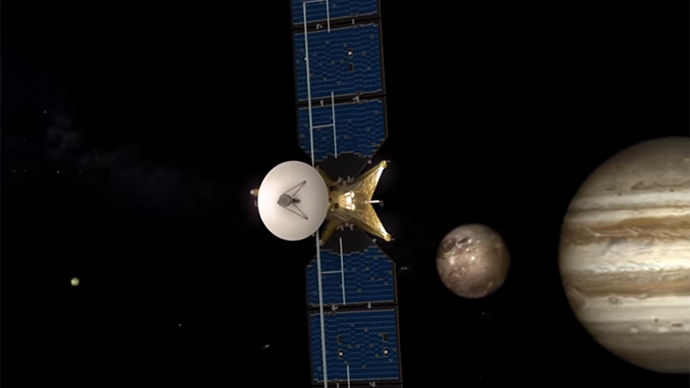Search for life: NASA begins work on mission to Jupiter moon Europa

The expansive ocean believed to reside under the surface of Jupiter’s icy moon Europa has been calling NASA’s name for years, and the space agency is now officially moving forward with a plan to see if alien life can actually exist there.
NASA announced Wednesday that its plan to survey Europa has been successfully reviewed by the agency and that it is now in the “formulation stage.” Essentially, this means that the Europa visit is no longer simply a concept, but a real mission that NASA is developing.
“Today we’re taking an exciting step from concept to mission, in our quest to find signs of life beyond Earth,” said John Grunsfeld, associate administrator for NASA’s Science Mission Directorate in Washington, in a statement. “Observations of Europa have provided us with tantalizing clues over the last two decades, and the time has come to seek answers to one of humanity’s most profound questions.”
READ MORE: NASA promises 'definitive evidence' of alien life by 2025
Europa has been considered a potential hotspot for alien life ever since the late 1990s, when NASA’s Galileo mission found evidence that a massive subsurface ocean might exist on the moon, which is roughly the size of Earth’s own. One huge difference between it and our own moon is that Europa could potentially have more than double the amount of water than there is on Earth.
Additionally, Europa’s ocean is believed to be warmer than it would be if it only received heat from the sun, since strong tidal forces on the planet generate heat as they flex. Scientists think the ocean features salt water and makes contact with a rocky sea floor, much like the Earth’s. All of these features, if proven to be true, point to the possibility that life may exist beneath the moon’s frozen surface.
“Europa is the most likely place to find life in our solar system today because we think there’s a liquid water ocean beneath its surface,” said Robert Pappalardo, a Europa mission project scientist, in a video released by NASA. “We know that on Earth, everywhere that there’s water, we find life. So could Europa have the ingredients to support life?”
While NASA is officially developing the mission now, the plan does not call for any sort of lunar landing (nor does it call for the use of some other exploratory device, like a drone that’s being considered for use on Saturn’s moon Titan). Instead, the mission is focused on determining Europa’s habitability, or the likelihood that it can sustain life.
To do this, NASA will send out a spacecraft sometime in the 2020s, which will eventually make it to Jupiter a few years later and stay in orbit there. The spacecraft won’t orbit around Europa since the moon is constantly being bombarded with heavy radiation from Jupiter, but it will swoop down past Europa 45 times over the course of the mission, taking high-resolution images of the surface for analysis. This way, NASA can take dozens of tours of Europa and not worry about its craft being quickly destroyed by radiation.
Since Europa was also found to shoot water vapor up to 200 kilometers into the air and into space, NASA’s probe will likely fly through these in order to analyze the composition of the moon’s watery interior.
“We might actually be looking at a body that is presently alive, presently active and presently undergoing its geology,” Claudia Alexander, the project manager of the Galileo mission from 1999-2003, said in NASA’s video. “There is too much evidence right now lying around on the surface … that suggests something’s going on there.”












